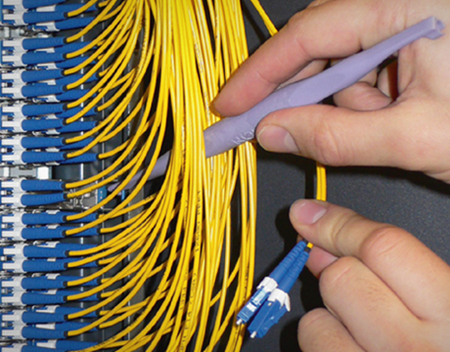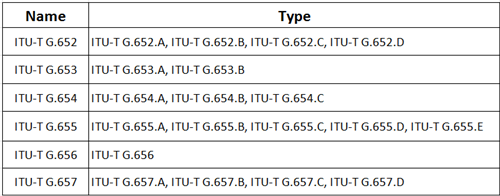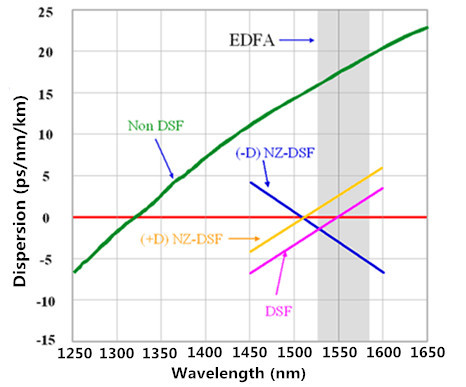Are you turning to deploying single-mode cables to speed up your infrastructure? If yes, let’s say you have made the right choice. In general, single-mode cables are typically categorized into OS1 and OS2 single-mode fibers. Besides this, a variety of SM optical fibers with carefully optimized characteristics are also available in ITU-T G.652, 653, 654, 655, 656 or 657 standard. Each has its unique specification, which reflects the evolution of transmission system technology from the earliest installation of single-mode optical fiber to the present day. Today’s article will make a brief introduction to the G.65x series of single mode fiber patch cables so as to assist you in making a wise selection.

G.652—The ITU-T G.652 fiber is the most commonly deployed single-mode fiber. This standard SM fiber comes in four variants (A, B, C, D) see in Figure 2. A and B have a water peak. C and D eliminate the water peak for full spectrum operation. The G.652.A and G.652.B fibers are designed to have a zero-dispersion wavelength near 1310 nm, therefore they are optimized for operation in the 1310nm band. The more recent variants (G.652.C and G.652.D) feature a reduced water peak that allows them to be used in the wavelength region between 1310 nm and 1550 nm supporting Coarse Wavelength Division Multiplexed (CWDM) transmission.

G.653—G.653 fiber is also called dispersion-shifted fiber (DSF). Compared with G.652, G.653 has a reduced core size, which is optimized for long-haul single-mode transmission systems using erbium-doped fiber amplifiers (EDFA). And the wavelength of zero chromatic dispersion was shifted up to 1550 nm. One of the most troublesome, four-wave mixing (FWM), occurs in a Dense Wavelength Division Multiplexed (CWDM) system with zero chromatic dispersion, causing unacceptable crosstalk and interference between channels.
G.654—G.654 fiber can handle higher power levels between 1500 nm and 1600 nm, which is mainly designed for extended long-haul undersea applications. It uses a larger core size made from pure silica to achieve the same long-haul performance with low attenuation in the 1550nm band. This G.654 specifications entitled “characteristics of a cut-off shifted single-mode optical fiber and cable.”
G.655—G.655 is known as non-zero dispersion-shifted fiber (NZDSF). It has a small, controlled amount of chromatic dispersion in the C-band (1530-1560 nm), where amplifiers work best, and has a larger core area than G.653 fiber. G.655 fiber overcomes problems associated with four-wave mixing and other nonlinear effects by moving the zero-dispersion wavelength outside the 1550nm operating window. There are two types of NZDSF, known as (-D)NZDSF and (+D)NZDSF. They have respectively a negative and positive slope versus wavelength. G.655 fibers were mainly used to support long-haul systems that use DWDM transmission.

G.656—The G.656 fiber is also called Medium Dispersion Fiber (MDF). It is designed for local access and long haul fiber that performs well at 1460 nm and 1625 nm. This kind of fiber was developed to support long-haul systems that use CWDM and DWDM transmission over the specified wavelength range. And at the same time, it allow the easier deployment of CWDM in metropolitan areas, and increase the capacity of fiber in DWDM systems.
G.657—G.657 optical fibers are intended to be compatible with the G.652 optical fibers but have differing bend sensitivity performance. It is designed to allow fibers to bend, without affecting performance. This is achieved through an optical trench that reflects stray light back into the core, rather than it being lost in the cladding, enabling greater bending of the fiber. G.657 as the latest standard for FTTH applications, along with G.652 is the most commonly used in last drop fiber networks.
Summary
In the above context, the passage has briefly weighted up G.652, G.653, G.654, G.655 and G.657 single-mode fibers. Note that G.657A is essentially a more expressive version of G.652D, with a superior bending loss performance and should you start feeling a little benevolent towards deploying it on a long-haul application. I can immediately confirm that this allows for a glimpse into the workings of silliness. Dispersion Shifted Fiber (DSF) in accordance with G.653 has no chromatic dispersion at 1550 nm. However, they are limited to single-wavelength operation due to non-linear four-wave mixing. G.654 compliant fibers were developed specifically for undersea un-regenerated systems.
Choosing the right single-mode fiber for your network application is a critical decision. Fiberstore single-mode optical cables provide the cost-effective combination of high-bandwidth performance and increased reliability. Our single-mode fibers are available in various types of connectors like the LC LC single mode patch cord, and can be utilized in many applications.
评论
发表评论